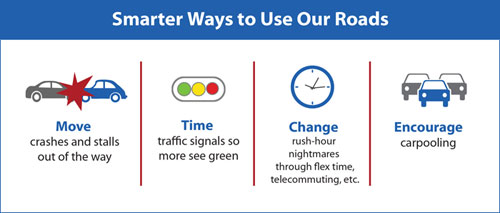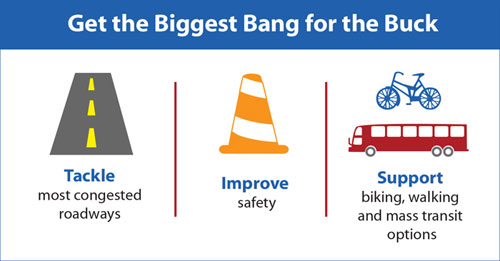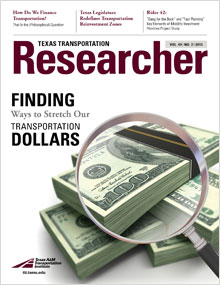Key Elements of Mobility Investment Priorities Project Study

Transportation was clearly a public policy focus in 2013 for Texas legislators, who worked diligently on a plan to add about $1 billion to the state’s annual road-building and maintenance budget, if approved by voters next year. But long before the 83rd Regular Session was gaveled to order, action taken during the previous legislative session was beginning to bear fruit.
When lawmakers gathered in 2011, they set aside $300 million to get the state’s highest-priority roadway projects moving, focusing primarily on the 50 most congested highway sections in Texas. They turned to the Texas A&M Transportation Institute (TTI) to help partner agencies prioritize projects to achieve the biggest bang for the buck in each of the state’s most populated regions.
The projects selected were directed by legislators to have the greatest impact considering congestion, economic benefits, user costs, safety and pavement quality. In addition, those projects should apply the best available traffic management and demand management principles, and public participation would ensure the most inclusive planning process possible.
Two years later, all parties involved in the Mobility Investment Priorities Project — spelled out in law as Rider 42 of the state budget for the Texas Department of Transportation (TxDOT) — can point to several noteworthy accomplishments.
-
By coordinating with TxDOT districts, metropolitan planning organizations, and other local agencies and governments, TTI staff helped implement a highly efficient process that identified priority projects and recommended funding levels to begin project development in only five months, well ahead of the traditional transportation planning schedule. Two examples of the impact these projects will have on the state’s most congested corridors are the 20-year acceleration in construction of US 290 in Houston and the completion of the funding for the Horseshoe Project near downtown Dallas.
-
TTI staff developed summaries of conditions and plans in the state’s most congested corridors in both one-pager (for quick comprehension) and longer (with technical implementation detail) formats. They also created more than 80 descriptions of congestion-reduction solutions, funding ideas and public-engagement strategies to assist agency and legislative staff, the business community, the general public, and the media in understanding the range of solutions aimed at reducing traffic congestion. These documents are accessible to all audiences through the project’s website.
-
After examining public-involvement practices in the congested regions and reviewing case studies in Texas and elsewhere, TTI staff produced Mobility Investment Priorities Project: Public Engagement Report. The report presents best practices for ensuring an inclusive planning process for transportation projects. Those practices include leveraging advanced technologies and virtual meetings to ensure that broader discussions occur about which congestion-reduction efforts the public might support, as well as how best to pay for those efforts.
-
TTI developed sample PowerPoint presentations and other materials to help the public better understand how the transportation system is funded and operated, the state’s transportation challenges, potential options for addressing those challenges, and the consequences of inaction.
-
TTI developed a computer simulation model of I-35 in Austin to explore various improvement ideas and communicate the funding challenges brought on by growth in jobs and population in Central Texas. The economic benefits of several large congestion-reduction projects in Houston, San Antonio and Austin were also explored using several new tools and techniques. These include using the Transportation Revenue Estimator and Needs Determination System model, developed for TxDOT by TTI, to improve knowledge about the expected returns from transportation infrastructure investment.
“Traffic congestion in our major cities is choking our highways and choking our economy. Without Rider 42 and a focus on our worst problems, we would have seen no action or progress on the state’s most congested roadways,” says State Sen. Tommy Williams, chair of the Senate Finance Committee and a major force behind the Mobility Investment Priorities Project. “It’s a single step forward, but it’s a very important step forward.”
The steps that need to be taken come in all sizes.
“We’ve created a checklist of ‘things we can do right now with relatively little funding,’ and these are appropriate for almost all situations,” says TTI Senior Research Engineer and Regents Fellow Tim Lomax, who directed the Institute’s efforts. “What we need to do is identify where each strategy can help, dismantle some institutional barriers, and consider these ideas as interim improvements before we get funding for the really big projects we need to address the state’s mobility challenges.”



